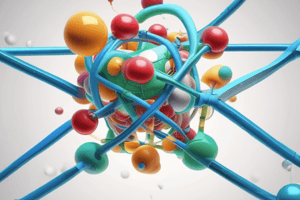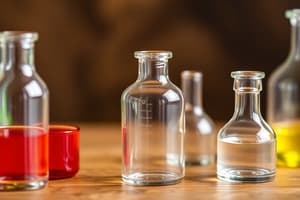Podcast
Questions and Answers
The symbol for Gold is ______.
The symbol for Gold is ______.
Au
The Latin name for Sodium is ______.
The Latin name for Sodium is ______.
Natrium
The symbol for Mercury is ______.
The symbol for Mercury is ______.
Hg
Flashcards
Atom
Atom
The smallest unit of an element that can exist independently. It is made up of protons, neutrons, and electrons.
Atomic Number
Atomic Number
The number of protons in the nucleus of an atom. It determines the element's identity.
Mass Number
Mass Number
The total number of protons and neutrons in the nucleus of an atom. It gives the atomic mass.
Isotopes
Isotopes
Signup and view all the flashcards
Isobars
Isobars
Signup and view all the flashcards
Signup and view all the flashcards
Study Notes
Learning Objectives
- Atoms and molecules are fundamental topics discussed
- Laws of chemical combination are included
- Dalton's atomic theory is a key concept
- Charged particles in matter (electrons, protons, and neutrons) are covered
- Models of the atom are explored
- Valency, atomic number, mass number, isotopes, and isobars are discussed
- Molecules, molecules of compounds, ions and molecular mass are all important concepts.
Discovery of an Atom
- Ancient Indian and Greek philosophers pondered the unseen form of matter
- Maharishi Kanad postulated that dividing matter leads to smallest particles (Parmanu)
- Pakudha Katyāyana elaborated that these particles exist combined
- Democritus and Leucippus proposed that matter can be divided infinitely until indivisible particles (Atoms)
- Antoine Lavoisier established two important laws of chemical combination
Laws of Chemical Combination
- Two fundamental laws are: Law of Conservation of Mass and Law of Constant Proportions
- Law of Conservation of Mass states that mass is neither created nor destroyed in a chemical reaction
- Law of Constant Proportions states that elements in a chemical compound always combine in a fixed ratio by mass
Dalton's Atomic Theory
- Dalton's atomic theory explains the Law of Conservation of Mass
- Matter consists of small particles called atoms
- Atoms are indivisible and indestructible
- Atoms of the same element are identical in mass and properties
- Atoms of different elements have different masses and properties
- Atoms combine in simple whole-number ratios to form compounds
Size of an Atom
- Atoms are very small, smaller than anything imaginable
- Millions of atoms would only make a thin layer
- Atomic radius is measured in nanometers
Symbols of Elements
- John Dalton was the first to use symbols for elements in a specific way
- A symbol represents a specific quantity of that element (one atom)
- Berzelius proposed using one or two letters from the element's name for symbols
- Element names often derive from the place where they were found
IUPAC Nomenclature
- IUPAC (International Union of Pure and Applied Chemistry) standardizes element names, symbols, and units
- The first letter of a symbol is always uppercase, the second lowercase
- Some symbols are derived from Latin, German, or Greek names
Symbols of Some Elements
- A table providing atomic numbers, symbols, and names of various elements
Name of Element and Latin Name
- A table showing the Latin names and symbols of various elements
Studying That Suits You
Use AI to generate personalized quizzes and flashcards to suit your learning preferences.




